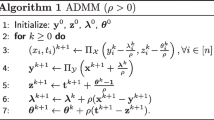Abstract
This paper proposes to employ the L1 norm criterion to perform the de-Hankelization in the singular spectrum analysis (SSA). In particular, the represented values of the off-diagonals in the two-dimensional SSA matrices are found via minimizing the L1 norm errors of the vectors defining as the absolute differences between the off-diagonal vectors and the vectors with all their elements being the represented values. This results to reduce the total number of the large-valued elements in the error vectors. Also, this paper guarantees to achieve the exact perfect reconstruction of the original signal. As the formulated problem is a standard linear programming problem, the solution could be efficiently found via the simplex method. The computer numerical simulations verify the results.






Similar content being viewed by others
References
Lin, P.-R., Li, W., Zheng, T., Ling, W.-K., Li, C.-K.: Information extraction via singular spectrum analysis for noninvasive blood glucose estimation system inspired by empirical mode decomposition. In: International conference on industrial informatics, INDIN, pp. 18–21 (2016)
Torkamani-Azar, F., Parkkinen, J.: Image quality assessment using block-based weighted SVD. Signal Image Video Process. 12, 1337–1344 (2018)
Zabalza, J., Ren, J., Wang, Z., Marshall, S., Wang, J.: Singular spectrum analysis for effective feature extraction in hyperspectral imaging. IEEE Geosci. Remote Sens. Lett. 11(11), 1886–1890 (2014)
Ji, H., Li, Y., Dong, E., Xue, P., Xiong, W., Sun, W., Tang, Z., Zhang, D., Fang, W.: A non-rigid image registration method based on multi-level B-spline and L 2-regularization. Signal Image Video Process. 12, 1217–1225 (2018)
Ramirez, C., Argaez, M.: An l1 minimization algorithm for non-smooth regularization in image processing. Signal Image Video Process. 9, 373–386 (2015)
Shi, L., Zhao, H.: L 1-norm constrained normalized subband adaptive filter algorithm with variable norm-bound parameter and improved version. Signal Image Video Process. 11, 865–871 (2017)
Li, Ya., Ling, B.W.-K., Xie, L., Dai, Q.: Using LASSO for formulating constraint of least-squares programming for solving one-norm equality constrained problem. Signal Image Video Process. 11, 179–186 (2017)
Huang, Z., Gu, J., Ling, W.-K.: De-Hankelization of singular spectrum analysis matrices via an optimization approach for blood glucose estimation. In: International conference on consumer electronics China, ICCE-China (2016)
Golyandina, N.E., Nekrutkin, V.V., Zhigljavsky, A.A.: Analysis of Time Series Structure: SSA and Related Techniques. Chapman and Hall/CRC, Boca Raton (2001)
Elsner, J.B., Tsonis, A.A.: Singular Spectrum Analysis: A New Tool in Time Series Analysis. Springer, Berlin (1996)
Touil, I., Benterki, D., Yassine, A.: A feasible primal-dual interior point method for linear semidefinite programming. J. Comput. Appl. Math. 312, 216–230 (2017)
Wu, Z.W., Yao, M.L., Ma, H.G., Jia, W.M.: De-noising MEMS inertial sensors for low-cost vehicular attitude estimation based on singular spectrum analysis and independent component analysis. Electron. Lett. 49, 892–893 (2013)
Wang, R., Man, H.G., Liu, G.Q., Zuo, D.G.: Selection of window length for singular spectrum analysis. J. Frankl. Inst. 352, 1541–1560 (2015)
Yang, Z., Ling, B. W.-K., Bingham, C.: Extracting underlying trend and predicting power usage via joint SSA and sparse binary programming. In: International symposium on circuits and systems, ISCAS, pp. 19–23 (2013)
Harmouche, J., Fourer, D., Auger, F., Borgnat, P., Flandrin, P.: The sliding singular spectrum analysis: a data-driven nonstationary signal decomposition tool. IEEE Trans. Signal Process. 16(1), 251–263 (2018)
Acknowledgements
This paper is supported partly by the National Nature Science Foundation of China (Nos. U1701266, 61372173, 61471132 and 61671163), the Guangdong Higher Education Engineering Technology Research Center for Big Data on Manufacturing Knowledge Patent (No. 501130144), the Natural Science Foundation of Guangdong Province China (No. 2014A030310346), the Science and Technology Planning Project of Guangdong Province China (No. 2015A030401090) and Enterprise Support Scheme, ITC Hong Kong SAR (S/E070/17).
Author information
Authors and Affiliations
Corresponding author
Additional information
Publisher's Note
Springer Nature remains neutral with regard to jurisdictional claims in published maps and institutional affiliations.
Rights and permissions
About this article
Cite this article
Huang, Z., Ling, B.WK. De-Hankelization of singular spectrum analysis matrices via L1 norm criterion. SIViP 13, 933–940 (2019). https://doi.org/10.1007/s11760-019-01430-7
Received:
Accepted:
Published:
Issue Date:
DOI: https://doi.org/10.1007/s11760-019-01430-7




